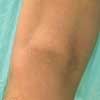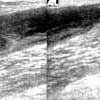- CDC
- Heart Failure
- Cardiovascular Clinical Consult
- Adult Immunization
- Hepatic Disease
- Rare Disorders
- Pediatric Immunization
- Implementing The Topcon Ocular Telehealth Platform
- Weight Management
- Monkeypox
- Guidelines
- Men's Health
- Psychiatry
- Allergy
- Nutrition
- Women's Health
- Cardiology
- Substance Use
- Pediatrics
- Kidney Disease
- Genetics
- Complimentary & Alternative Medicine
- Dermatology
- Endocrinology
- Oral Medicine
- Otorhinolaryngologic Diseases
- Pain
- Gastrointestinal Disorders
- Geriatrics
- Infection
- Musculoskeletal Disorders
- Obesity
- Rheumatology
- Technology
- Cancer
- Nephrology
- Anemia
- Neurology
- Pulmonology
Baker Cyst in a Runner
For several days, a 38-year-old man has had an increasingly painful swelling behind the right knee. He runs several times a week. He has hypertension but no history of trauma or periods of inactivity, and no chest discomfort or shortness of breath. He drinks alcohol occasionally but does not use tobacco or illegal drugs.

THE CASE: For several days, a 38-year-old man has had an increasingly painful swelling behind the right knee. He runs several times a week. He has hypertension but no history of trauma or periods of inactivity, and no chest discomfort or shortness of breath. He drinks alcohol occasionally but does not use tobacco or illegal drugs.
Examination reveals a swollen soft tissue mass in the posterior popliteal fossa and an intact popliteal pulse. Sensation is intact; range of motion is minimally reduced with knee flexion. There is no erythema or warmth.
What do you suspect?
- Deep venous thrombosis (DVT)
- Popliteal aneurysm
- Baker cyst
- Gastrocnemius tear
(Answer and discussion on next page.)

Figure
DISCUSSION: Vascular ultrasonography (Figure) revealed a Baker (popliteal) cyst, the most common mass of the popliteal fossa. First described in 1877 by Dr William Baker, this synovial cyst results from fluid distention of the gastrocnemius-semitendinosus bursa. Baker cysts lie between the tendons of the medial head of the semimembranous and gastrocnemius muscles, posterior to the femoral condyle. These cysts affect both sexes and all races. Although they are sometimes seen in children, especially those with juvenile rheumatoid arthritis or trauma, they typically affect adults.
The most common presenting symptoms are a popliteal mass or swelling, aching, and knee effusion. Patients may also report buckling, cracking, or locking of the knee. Associated conditions include the arthritides (such as osteoarthritis, rheumatoid arthritis, gout, and systemic lupus erythematosus); infection (tuberculosis and septic arthritis); long-standing dialysis; and internal derangement (anterior cruciate or meniscal tears and osteochondral fractures).
Potential complications of Baker cyst include rupture or dissection (pseudothrombophlebitis syndrome), DVT, infection, pulmonary embolism, leakage, and posterior compartment syndrome.
The diagnosis may be confirmed by ultrasonography, CT, arthroscopy, or MRI. Treatment involves assisted weight bearing, anti-inflammatory agents, and ice. Arthroscopy is useful for internal derangements of the knee.
The principal signs and symptoms of DVT are unilateral leg edema, leg pain or tenderness, and warmth or erythema over the area of thrombosis. Risk factors include trauma, vasculitis, medications, and a number of medical conditions. DVT may be diagnosed with duplex ultrasonography, impedance plethysmography, nuclear medicine imaging studies, or MRI.
About 0.2% to 11% of patients with Baker cyst have coexisting DVT. Therefore, DVT must be ruled out in patients who are undergoing ultrasonography to identify a possible Baker cyst.
Popliteal aneurysms are the most common peripheral aneurysms. Although the cause is unknown, they are thought to be related to trauma or atherosclerosis. Historically, such aneurysms were believed to be associated with syphilitic, mycotic, or traumatic events. Popliteal aneurysms are bilateral in 50% to 70% of cases and occur in 0.01% of hospitalized patients.
Distal embolization or aneurysmal thrombosis may produce symptoms of popliteal occlusion or claudication. However, patients are often asymptomatic at the time of diagnosis. Popliteal aneurysms typically affect persons in their 50s or 60s; most patients present with a pulsatile mass or soft tissue swelling in the popliteal fossa. Diagnosis is confirmed with duplex ultrasonography or angiography. Vascular bypass is the treatment of choice; amputation may be necessary.
A gastrocnemius tear often results from an acute, forceful push-off with the foot. Although this injury may occur with any activity, it is seen most frequently with hill running, tennis, and jumping. The intermittently active athlete ("weekend warrior") is prone to this disorder. Patients are typically men in their fourth to sixth decade of life.
Presenting symptoms include a feeling that something is "stuck" in the calf; an audible pop in the calf; pain in the calf that radiates to the ankle or knee; or swelling of the leg, including the foot or ankle. Examination often reveals tenderness on palpation of the gastrocnemius muscle, asymmetric calf swelling and discoloration, and a defect in the medial gastrocnemius muscle if the swelling has resolved.
A gastrocnemius tear is generally diagnosed clinically. Radiographic imaging and laboratory evaluation are reserved for investigation of other possible causes of the physical findings.
References:
FOR MORE INFORMATION:
- Baker WM. On the formation of synovial cysts in the leg in connection with disease of the knee joint. St Bartholomew's Hosp Rep. 1877;13:245-261.m Glazer JL, Hosey RG. Soft-tissue injuries of the lower extremity. Prim Care. 2004;31:1005-1024.
- Langsfeld M, Matteson B, Johnson W. Baker's cysts mimicking the symptoms of deep vein thrombosis: diagnosis with venous duplex scanning. J Vasc Surg. 1997;25:658-662.
